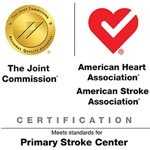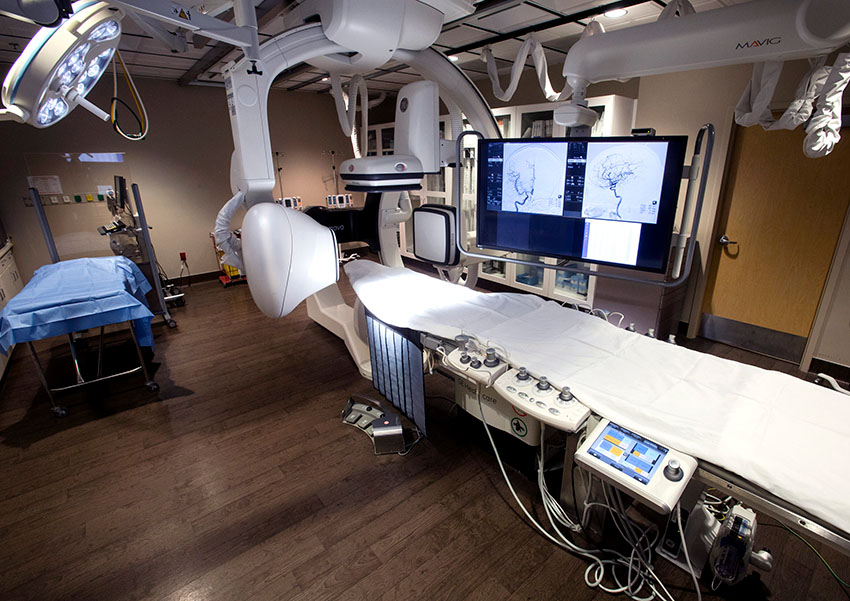Southern Hills Hospital and Medical Center offers advanced and highest quality of care in the treatment of Neurovascular diseases, including comprehensive stroke services. From emergency medical service workers in the field to our team of experienced doctors and nurses standing by 24/7, we are always ready to care for you or a loved one. We also prioritize education and awareness to promote neurological wellness throughout Clark County and Southern Nevada.
A stroke is a medical emergency. If you or someone you know is exhibiting signs of a stroke, call 911 immediately.
Recognition

Southern Hills Hospital is a Certified Primary Stroke Center recognized by The Joint Commission. This designation recognizes our hospital for providing complete stroke services, including diagnosis, treatment, education, and outreach.
Neurointernvetional program
The mission of our neurointerventional program is to provide neurovascular services to our community including diagnostic catheter angiography, open surgical and endovascular, neurosurgery of cerebrovascular diseases and neurocritical care.
What are neurointervenional procedures?
Neurointerventional procedures also known as interventional neurology, utilizes advanced minimally invasive techniques to treat complex diseases that affect the spine and brain.

Our dedicated multidisciplinary team of professionals utilize state of the art technology and clinical best practices in neuroimaging, endovascular device development and advanced techniques in image guided minimally invasive procedures. Our first and most important responsibility is to our patients and their families, ensuring they receive the best healthcare possible.
At Southern Hills Hospital we focus not only on the treatment of strokes but stroke prevention as well.
Stroke treatment
- Transcarotid artery revascularization (TCAR)
- Aneurysm coiling/clipping
- Clot busting medication
Stroke prevention
- Aneurysm coiling
- AVM embolization
- Carotid stinting
Stroke prevention
To help reduce your chance of getting a stroke, take the following actions:
- Check your blood pressure frequently. Follow your doctor's recommendations for keeping it in a safe range.
- Don't use recreational drugs, such as cocaine, heroin, marijuana and amphetamines.
- Drink alcohol only in moderation (no more than two drinks per day).
- Eat more fruits and vegetables, and limit your intake of salt and fat.
- Exercise regularly.
- Increase your consumption of fish.
- Maintain a healthy weight.
- Seek medical care if you have symptoms of a stroke (even if they stop).
- Stop smoking.
- Take a low dose of aspirin (50-325 milligrams per day) if your doctor says it is safe.
- Take steps to keep chronic medical conditions under control. This includes high cholesterol and diabetes.
- Talk to your doctor about the use of a "statin" drug. It may help prevent certain kinds of strokes.
Identifying the warning signs of a stroke
According to the American Heart Association and American Stroke Association, stroke is the third leading cause of death in the United States and a leading cause of serious, long-term disability. About 795,000 Americans each year suffer a new or recurrent stroke. That means, on average, a stroke occurs every 40 seconds. Strokes kill more than 137,000 people a year. That's about one of every 18 deaths. On average, someone dies from stroke every 4 minutes.
Stroke symptoms
Stroke symptoms occur suddenly but differ depending on the part of the brain affected. Also, multiple symptoms can happen at the same time. If you notice any of the issues below, call 911 right away and get to an emergency room as soon as possible:
- Sudden confusion
- Sudden dizziness, trouble walking, loss of balance or loss of coordination
- Sudden severe headache with no known cause
- Sudden trouble seeing in one or both eyes
- Sudden trouble speaking or understanding
- Sudden weakness or numbness of face, arm or leg, especially on one side of the body
Severe headaches or vertigo (dizziness) can accompany a stroke, but these symptoms aren't typical. However, a sudden change of vision associated with weakness may signal a stroke. Be sure to note when symptoms first appeared, and don't try to drive yourself or a loved one to a hospital. Call for an ambulance so treatment can begin immediately.
If someone is having a stroke, remember to B.E. F.A.S.T.:
- B(alance)—Does the person have a sudden loss of balance?
- E(ye)—Has the person lost vision in one or both eyes?
- F(ace)—Watch for facial drooping. Ask the person to smile, and check if one side of the face droops.
- A(rms)—Ask the person to raise both arms. Does one arm drift downward?
- S(peech)—Listen for slurred speech. Ask the person to repeat a simple phrase. Can they do it?
- T(ime)—If you notice any of these symptoms, call 911 immediately. Even if the symptoms go away, you should still call for help.
Types of strokes we treat
Our neurological team is ready and equipped to treat all types of stroke. The three main types of strokes people experience are:
Ischemic strokes
Ischemic strokes (the most common type of stroke) occur when an artery that supplies the brain is greatly narrowed or blocked. A buildup of plaque causes the artery to narrow. Plaque in the arteries can break off in small pieces, or the rough edges can cause blood clots. Blood clots eventually break free and become stuck in small blood vessels in the brain.
Hemorrhagic strokes
Hemorrhagic strokes occur less frequently than ischemic strokes. However, they're responsible for 30 percent of all stroke deaths. Instead of a blockage, hemorrhagic strokes occur when a blood vessel in the brain ruptures, allowing blood to flow freely into the skull and brain tissue. This blood flow causes damage to the brain cells. Some people have defects in their blood vessels of the brain that make this more likely to occur.
Transient ischemic attacks (TIAs)
TIAs are often called "mini strokes" because they're caused by a temporary blockage of the artery and leave no permanent brain damage. The symptoms of a TIA will go away within 24 hours, depending on which artery is blocked. It's often treated the same as stroke because the symptoms can be similar.
TIAs are a warning sign that should be discussed with your physician. More than 30 percent of people who experience TIAs ultimately experience a stroke.
Transcarotid Artery Revascularization (TCAR)
Southern Hills Hospital and Medical Center offers transcarotid artery revascularization (TCAR), the most advanced stroke treatment. For patients with carotid artery disease, a potential complication of surgery (carotid endarterectomy or CEA) and stenting for stroke prevention is a stroke occurring during the procedure. Studies have shown a higher stroke risk during conventional stenting than surgery. TCAR prevents the need to navigate catheters through the aortic arch — a step linked to stroke during carotid stenting through the groin.
To reduce the risk of stroke during the stent insertion, the TCAR procedure uses a special transcarotid neuro-protection system (NPS). The NPS device allows the surgeon to directly access the common carotid artery in the neck and initiate high-rate temporary blood flow reversal to protect the brain from stroke while delivering and implanting the stent.
Performed through a small incision at the neckline just above the clavicle, a surgeon places a tube directly into the carotid artery and connects it to the NPS, directing blood flow away from the brain to protect against plaque from reaching the brain.
The patient’s blood flows through the NPS, and any material is captured in a filter outside the body. The filtered blood is returned through a second tube in the patient’s upper leg. After successful stent placement, flow reversal is turned off, and blood flow resumes in its normal direction.
TCAR not only obviates the need to navigate catheters through the aortic arch (a step linked to stroke during carotid stenting through the groin), but also prevents fragments of plaque released during stenting from traveling with the bloodstream to the brain and causing small or bigger strokes.